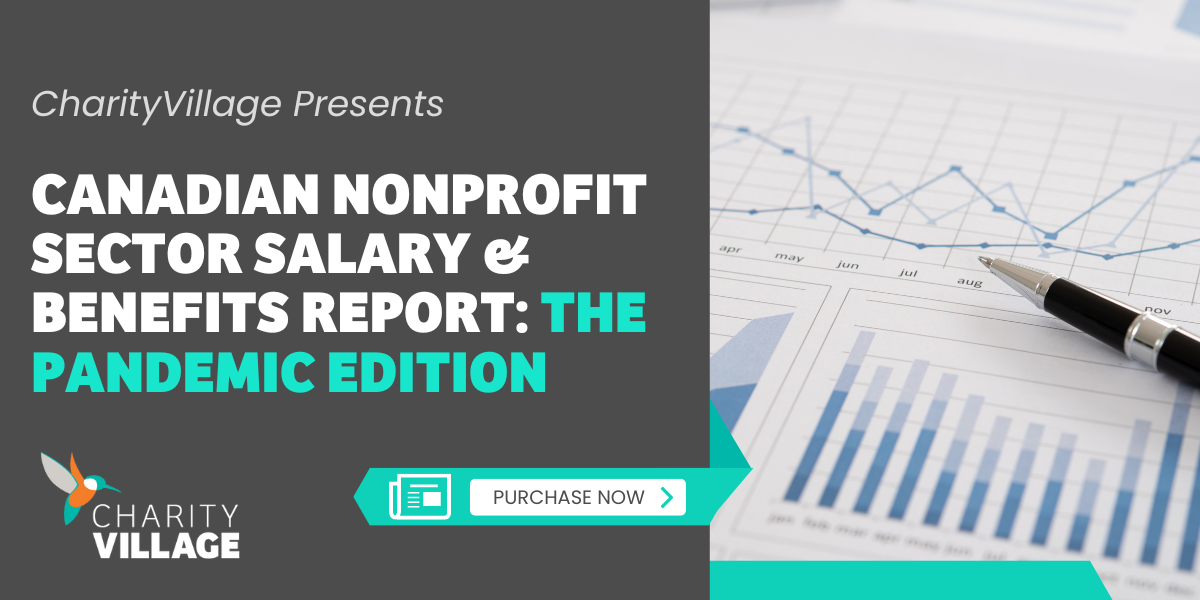Want to learn more about how to put the 2022 Canadian Nonprofit Sector Salary & Benefits Report to work at your organization and in your career? Watch our free webinar recording!
Editor’s Note: Click here to download the report’s Table of Contents and Executive Summary.
How have nonprofit salary and benefit packages changed over the course of the COVID-19 pandemic? New data from the CharityVillage Canadian Nonprofit Sector Salary & Benefits Report: The Pandemic Edition suggests that cash compensation has continued to increase across the sector over the past year, despite the economic challenges and other impacts faced by many nonprofit organizations. The goal of this year’s report is to provide current salary and benefits data to the nonprofit sector as we continue to deal with these impacts, even if there is uncertainty or disagreement as to when we’ll be in a “post-pandemic” period.
To better understand the post-pandemic compensation trends in Canada’s nonprofit sector, we surveyed more than 1,200 organizations representing more than 13,000 individual employees from nonprofits and charities across Canada. Participation in this year’s survey was among our highest ever and the results are gathered in our 2022 salary and benefits report, now available for online purchase.
The findings are helpful for both sides of the hiring equation: Hiring managers can compare their compensation offerings with other organizations of similar size, sector and location, while individuals can research salary and benefits packages by similar criteria to confidently discuss salary expectations with current and potential employers.
Information in the report is broken out across six different job levels:
- Chief Executive
- Senior Executive
- Senior Management
- Management/Supervisory Staff
- Functional & Program Staff
- Support Staff.
Cash compensation is also detailed by geographic region, profession, and organization size, type, and focus. The report also includes extensive information on incentive plans and non-cash benefits programs.
Here are some highlights from the 2022 edition:
Cash compensation continues to grow across all nonprofit job levels
Cash compensation has increased at all levels since the last study was completed in 2020. The largest gains over the previous 18 months were among functional and program staff (7.4%), senior executives (5.9%), and senior management (4.7%).
What does this mean in terms of average salaries for each job level? Our data suggests that the 2022 average cash compensation for each nonprofit job level are as follows:
- Chief Executives – $100,881
- Senior Executives – $107,114
- Senior Management – $85,141
- Management/Supervisory Staff – $63,861
- Functional & Program Staff – $49,129
- Support Staff – $44,464
These averages are based on aggregated national data and may fluctuate significantly depending on organization size, focus, and location. Detailed breakdowns of average cash compensation based on these additional factors can be found within the report.
Average compensation is generally tied to the organization’s focus
Organizational focus refers to the area or sector in which the nonprofit operates. The most common organizational focus among the survey participants was social services (24%), followed by community benefit (12%), health organizations (11%), arts & culture organizations (10%), and children/family (7%) and education (7%) .
At all four management levels, health-related organizations continue to lead the way in cash compensation. For non-management positions, education organizations have the highest average compensation.
GTA is back at the top for the highest compensation in most job levels
In our last survey, Ottawa had edged ahead of the Greater Toronto Area (GTA) as the market leader with the highest compensation for staff across all levels, with the exception of support staff, where Alberta ranked first.
This year’s report has seen a reversal with the GTA back at the top for cash compensation at all levels except senior management, where Ottawa ranks first. Ottawa is the runner-up to the GTA in cash compensation in most job levels, with the exception of support staff, where Alberta places second.
Majority of organizations offer some benefits to some staff
Four in five (82%) participating organizations provide health benefits to at least one level of staff and 53% of participating organizations offer retirement benefits to at least some of their employees. This remains consistent with data from 2020.
Primary health benefits include prescription drug plans, extended health care/major medical insurance, dental plans, benefit coverage for family & dependents, alternative therapy insurance, life insurance, vision care, employee assistance programs (EAP) and accidental death and dismemberment.
Both employees and organizations invest in education
The vast majority of nonprofit staff have some form of post-secondary education. The level of education continues to increase with seniority – the higher the management level, the higher the likelihood of having post-graduate and Masters-level education. As seen in past studies, higher education generally correlates to higher compensation, particularly if the degree/diploma is relevant to the job. Between 73% and 80% of nonprofit staff receive some type of education benefits from their organization.
Gender pay gap continues, especially at the Chief Executive level
The gap between compensation for men and women in the nonprofit sector continues to show men earning more than women at all management levels. The gap is largest at the chief executive level (19%). While high, the gap is considerably lower than the 26% reported in the 2021 study. At other management levels, the gap ranges from 6% to 8%.
We know that accurate salary information specific to the nonprofit sector is vital to workforce planning in your organization and in your career. On the heels of the COVID-19 pandemic, with changed employer and employee behaviours, such data is more critical than ever.
Purchase your copy of the 2022 Canadian Nonprofit Sector Salary & Benefits Study today!








